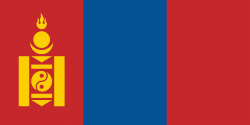Ulaan-Uul (Ulaan-Uul)
Ulaan-Uul (Улаан-Уул = red mountain) is a sum of Khövsgöl aimag. The area is close to 10,000 km2. In 2000, Ulaan-Uul had a population of 3,726 people, mainly Darkhad. The sum center, officially named Tögöl (Төгөл), is located 171 km north-north-west of Mörön and 942 km from Ulaanbaatar.
The Ulaan-Uul sum was formed from the bigger part of Bayanzürkh sum in 1933. From 1956 to 1990, it was the seat of the Jargalant Amidral negdel.
The Ulaan-Uul sum was formed from the bigger part of Bayanzürkh sum in 1933. From 1956 to 1990, it was the seat of the Jargalant Amidral negdel.
Map - Ulaan-Uul (Ulaan-Uul)
Map
Country - Mongolia
 |
|
| Flag of Mongolia | |
The territory of modern-day Mongolia has been ruled by various nomadic empires, including the Xiongnu, the Xianbei, the Rouran, the First Turkic Khaganate, and others. In 1206, Genghis Khan founded the Mongol Empire, which became the largest contiguous land empire in history. His grandson Kublai Khan conquered China proper and established the Yuan dynasty. After the collapse of the Yuan, the Mongols retreated to Mongolia and resumed their earlier pattern of factional conflict, except during the era of Dayan Khan and Tumen Zasagt Khan. In the 16th century, Tibetan Buddhism spread to Mongolia, being further led by the Manchu-founded Qing dynasty, which absorbed the country in the 17th century. By the early 20th century, almost one-third of the adult male population were Buddhist monks. After the collapse of the Qing dynasty in 1911, Mongolia declared independence, and achieved actual independence from the Republic of China in 1921. Shortly thereafter, the country became a satellite state of the Soviet Union, which had aided its independence from China. In 1924, the Mongolian People's Republic was founded as a socialist state. After the anti-communist revolutions of 1989, Mongolia conducted its own peaceful democratic revolution in early 1990. This led to a multi-party system, a new constitution of 1992, and transition to a market economy.
Currency / Language
| ISO | Currency | Symbol | Significant figures |
|---|---|---|---|
| MNT | Mongolian tögrög | ₮ | 2 |
| ISO | Language |
|---|---|
| MN | Mongolian language |
| RU | Russian language |















